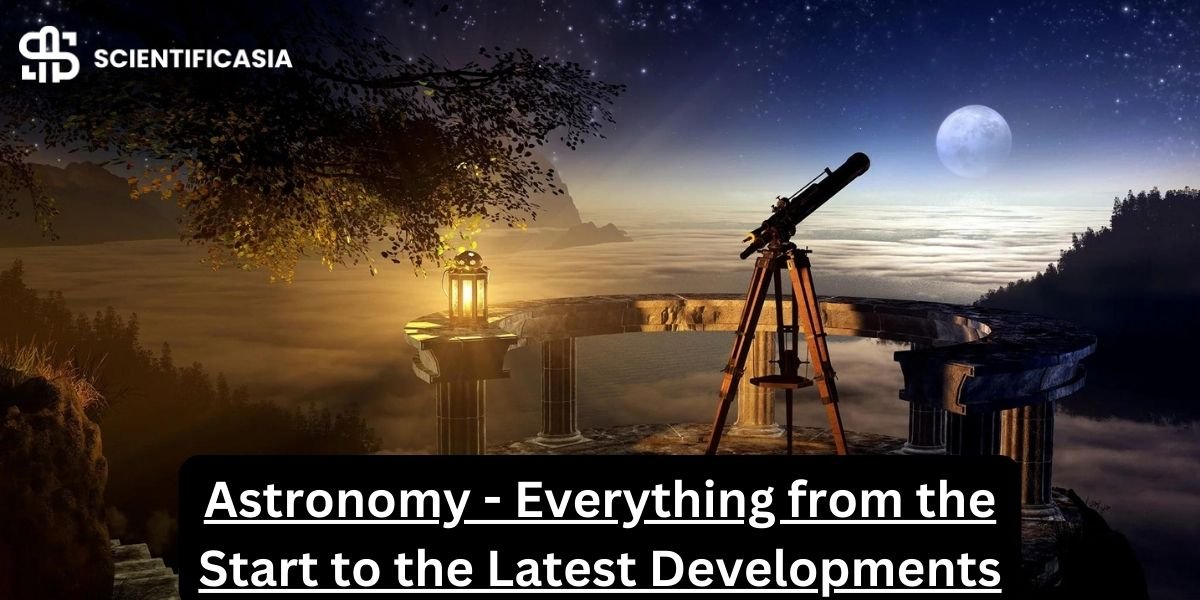The scientific study of space, heavenly bodies, and the cosmos as a whole is known as astronomy. It investigates events that occur outside of Earth’s atmosphere, such as the behavior, origin, and development of galaxies, stars, planets, moons, and other cosmic bodies. Astronomy is one of the oldest sciences in the world, has a lot to offer, and is one of the diverse disciplines that still require a lot of exploration. The real definition of astronomy revolves around studying the Earth, its atmosphere, and beyond. It also covers the glorious Sun, Moon, planets, stars, and almost everything humans can think of that exists in the universe. It is not possible to define the whole of astronomy science in a single paragraph as this field is as big as the galaxies we still don’t even know of.
To get your interest in this fascinating field, one mind-blowing fact about astronomy is that scientists state that the universe is expanding at an accelerating rate, and the movement of light emitted by distant supernovae (explosion of a star) is much faster than expected. One of the earliest disciplines is astronomy, which has its roots in the observations of the night sky made by ancient societies. To comprehend how the cosmos functions, from the tiniest particles to the enormous expanses of space and time, it now integrates numerous disciplines including physics, mathematics, and chemistry. Astronomers employ sophisticated telescopes and space missions to expand our understanding of the universe thanks to technological breakthroughs.
History of Astronomy
As one of the oldest disciplines, Astronomy has a rich history and is on the list of one of the first natural sciences that early civilizations started exploring. The first documented records of systematic astronomical observations date back to 1000 BCE, to the Assryo-Babylonias. Here are some of the historical highlights of Astronomy.
Ancient Greece
The Greeks were innovators in many fields of science, including astronomy information. Thales, Anaximander, and Pythagoras were among the earliest Greek philosophers to study the stars and planets, and their work provided the groundwork for modern astronomy. Many constellations and star names are still taken from Greek mythology, reflecting the long-lasting impact of Greek astronomy on our knowledge of the cosmos.
Greek Discovery: The First Stellar Catalog
A Greek astronomer compiled the first star list in the 2nd century BC. His name was Hipparchus who has a prominent name in the list of astronomers in the ancient world. His inventory contained the locations and magnitudes of nearly 1,000 stars.
The Dark Ages Progress
The era of the Dark Ages, which spanned from the fifth through the tenth centuries AD, is commonly seen as a period of stagnation and deterioration. However, recent studies have revealed that important scientific and technical advancements were accomplished during this period, notably in the discipline of astronomy. The universe science flourished in this era with Muslim scientists discovering several new astronomical elements, including the compilation of steller catalogs. Islamic scholars introduced different new instruments that can be used to determine the angles of stars and other elements in the sky. Many prominent names including Al-Khwarizmi, Ulugh Beg, and Copernicus transformed astronomy science.
Recent Trends in Astronomy

The current astronomy trends are focused on exploring new horizons to make life possible beyond Earth. Here are some of the major highlights that are of great importance to every stargazer out there.
Sloan Digital Sky Survey
One of the most revolutionary astronomical initiatives of our time is the Sloan Digital Sky Survey. SDSS has transformed how we study the cosmos since its inception in 2000, giving us an extraordinarily precise picture of the night sky. This map, composed of millions of pictures, spectra, and objects, has assisted astronomers in answering some of the most fundamental mysteries about our cosmos. The SDSS, which has cataloged over 500 million celestial objects like stars, galaxies, and quasars, has enabled astronomers to explore the distribution of matter in the universe, the history of galaxies, and the characteristics of dark matter and dark energy.
Canada-France-Hawaii Telescope
The Canada-France-Hawaii Telescope (CFHT) is a wonderful piece of equipment that has helped us better comprehend the cosmos. The CFHT astronomical telescope, which is located on the summit of Mauna Kea in Hawaii, has been in operation since 1979 and has made several discoveries throughout the years. Its primary mirror has a diameter of 3.6 meters, allowing it to collect a substantial amount of light from distant astronomical objects. As a result, it is an excellent instrument for researching anything from neighboring planets to distant galaxies.
Cosmic Background Imager
The Cosmic Background Imager (CBI) is a wonderful technology that has allowed us to peer into the very beginnings of the cosmos. The CBI is a network of 13 radio skywatching telescopes in the Chilean Andes that work together to construct a high-resolution picture of cosmic microwave background radiation. This radiation represents the Big Bang’s afterglow and contains vital information about the universe’s genesis and evolution. Scientists may learn about the distribution of matter in the early universe, the birth of galaxies and stars, and the nature of dark matter and dark energy by examining cosmic microwave background radiation.
Latest Discoveries In Astronomy
Astronomers are busy finding out the mysteries of the universe. However, the vastness of space is unending, and this is why astronomy is one of the most demanding fields which always requires researchers and mathematicians. Here are some of the latest discoveries in Astronomy for 2024.
Rise of Exoplanets – AI Technology in Action
The exoplanets are on the rise and this latest discovery is made possible with the help of Artificial Intelligence technology. The latest research comes from the papers of LMU Munich, and the Max Planck Institute for Extraterrestrial Physics. The astronomers have achieved new findings in the name of exoplanets. The data from ORIGINS Data Science Lab (ODSL) indicates that the latest AI models have made it possible to improve the working of JWST (James Webb Space Telescopes which now enables them to analyze far more distant planets (exoplanets) with new models of Physics. This even enhances the potential of AI in physics and increases the dataset further to refine the existing research and better stimulate the movements and behavior of planets in space.
Supermassive Blackhole Right in Galaxy’s Center – Study Reveals
Another latest discovery from August 2024 shows a supermassive black hole right at the center of our Galaxy, the Milky Way. The astronomers are referring to this blackhole as Sagittarius which is predicted to be formed due to a cosmic merger in the galaxy’s celestial objects. The Event Horizon Telescope (EHT) helped astronomers to capture the first direct image of the Sagittarius (Sgr A*) back in 2022, but the unusual spin of the black hole has made it align with the Milky Way’s center. This angular momentum of the merger can be explained with the help of another merger which is possibly from the satellite Galaxy. A 4:1 mass ratio of the inclined orbital is indicated by the scientists. The scientists further predict this happening to link back around 9 billion years ago as it replicates the Milky Way’s merger with the Gaia-Encaladus Galaxy. The findings provide crucial insights into the dynamical history of our galaxy and will inform future observations with upcoming space-borne gravitational wave detectors like the Laser Interferometer Space Antenna (LISA), which is planned for launch in 2035.
Mysterious Moving Planet
The third latest discovery of 2024 is interesting yet challenging to the current findings of Astronomy. This research comes from the team at Swedish Lund University and highlights the presence of another small exoplanet present 455 light years from Earth. The TOI-1408c is a small mysterious exoplanet that has been identified by Swedish scientists and they specify the properties of this planet. The mass is around Eight Earths and exhibits unexpected variations that suggest complex rotations. The scientists name it as Rhythmic Dance. The discovery has raised a challenge to the existing NASA Transitioning Exoplanet Survey Satellite (TESS).
Related Article: What time is the Solar Eclipse 2024?
Astrology and Astronomy – A Quick Comparison
Astrology and astronomy are two words that are used interchangeably yet are completely distinct concepts. Let’s break it down: astrology is the study of how celestial bodies (such as stars and planets) impact human behavior and occurrences on Earth. It is a discipline that has been practiced for thousands of years and has played an essential role in many societies throughout history.
On the other hand, Astronomy is the scientific study of the cosmos beyond our planet, concentrating on the physics and chemistry of celestial objects and their motions. While astrology and astronomy both have a fascination with the stars, they are essentially separate sciences with distinct methods of comprehending the universe.
So, the next time you check your horoscope for the upcoming week or gaze up at the night sky, remember that while astrology and astronomy have similar beginnings, their methodologies and purposes are separate and completely unique.
The Universe
Despite the numerous unsolved mysteries, the universe continues to amaze and inspire people all around the world. For ages, the cosmos has captivated our minds and stimulated our curiosity, from the majestic magnificence of the stars and galaxies to the fundamental rules of physics that govern its activity. As we continue to explore and study the universe, we will undoubtedly make more exciting discoveries that will change our knowledge of the universe.
How Old is It?
The universe is a big and amazing realm full of innumerable mysteries that we have only started to explore. It is believed that the universe is about 13.8 billion years old. The universe has continued to evolve since these early days, giving rise to galaxies, stars, and planets and eventually leading to the creation of life on Earth.
Planetary Science
Other than the Earth and other known celestial bodies, the universe is composed of undiscovered planets and galaxies that we still don’t even know of. The study of these planets and elements has formed a completely new field known as planetary science. It is a fascinating and dynamic field of study that focuses on the research and understanding of our solar system’s planets, moons, asteroids, and other celestial bodies. It is a multidisciplinary subject that uses information from astronomy, geology, physics, chemistry, and many other sciences to help us solve the universe’s riddles. Planetary scientists seek answers to concerns regarding the solar system’s origins and development, the geology and atmospheres of planets and moons, the potential of life beyond Earth, and much more.
Astrology and The Branches it Extends

Coming back to Astrology, the field is vast and extends to different branches that interconnect with other areas of science. It is based on the belief that heavenly bodies’ locations and motions might impact human affairs and personality attributes. Horoscopes, which employ the positions of the sun, moon, and planets at the time of a person’s birth to foretell their future, are typically connected with astrology. Here are some of the most prominent branches that extend from astronomy:
Astrophysics
Starting with the combination of Astrology and physics. A branch of science that tries to comprehend the characteristics and behavior of celestial bodies using physical principles is known as Astrophysics which covers everything from stars and galaxies to black holes and dark stuff. Astrophysics enables us to investigate the underlying nature of the cosmos and to comprehend the mechanisms that regulate its activity. In Astronomy and Astrophysics, scientists investigate the light and radiation emitted by celestial objects using telescopes and other observational methods, revealing insights into their composition and behavior. By studying astrophysics, we can get a better understanding of the universe’s beginnings and development, as well as greater respect for its vastness and complexity.
Astrobiology
The next branch that is doing wonders in the scientific world is Astrobiology. It is the scientific field that investigates the potential of life beyond Earth. It aims to understand how life can develop in other regions of the universe and what the required circumstances for life would be. People who study life beyond Earth are Astrobiologists who investigate the possibility of life in our solar system as well as other planetary systems around the cosmos. They also research extremophiles, or creatures that can live in harsh circumstances on Earth, to better comprehend the possibility of life existing in comparable harsh environments elsewhere in the cosmos.
Cosmology
Moving onto the third most prominent branch that is integral to astronomy is cosmology. It is the exploration of the universe’s creation and development. In this field, scientists try to comprehend the underlying rules that govern the universe’s behavior, as well as the processes that have molded its evolution over time. Cosmologists examine the structure and composition of the cosmos using a range of observational methods, such as telescopes and satellites. They also evaluate and enhance our knowledge of the universe’s dynamics via theoretical models and simulations. Cosmology allows us to get a better knowledge of the world and our role within it, as well as investigate some of the most fundamental issues concerning the existence and the nature of reality.
Future of Astronomy
In the future, as some people regard astrology as pseudoscience, many experts find it essential for self-reflection and personal development. There are many interesting changes in astrology on the horizon as we move forward. For example, the advancements in technology and data analysis are allowing astrological patterns to be analyzed on a far greater scale, which can lead to new avenues of insights and discoveries.
The Recent Events in Astronomy: The Great Conjunction of Venus and Jupiter on 02 March 2023 is especially remarkable as these two planets aligned in the air. Whether or not you believe in astrology, it is apparent that this ancient technique will continue to amaze and enchant people for many years to come. Other than the upcoming events here are two main emerging disciplines of astrology that will define the future of space science.
Neutrinos
Neutrinos are extremely small particles produced by nuclear processes that are linked to stars. Despite being one of the most numerous particles in the cosmos, they are significantly difficult to detect because they interact with other matter so weakly. The study of neutrinos is an intriguing field of research because it provides unique insights into the behavior of the cosmos at its most fundamental level. Recent technological advancements have improved the detection of neutrinos, and there is rising interest in exploiting them to better comprehend the inner workings of stars and other celestial entities.
Exobiology
Emerging from the field of Astrobiology, exobiology is also focused on finding the lifelike elements beyond Earth. The recent discoveries of planets in other stars’ habitable zones have only contributed to the enthusiasm surrounding exobiology, as researchers try to identify prospective targets for future research. Exobiology promises to be a vibrant and ever-evolving subject of study as we continue to explore the universe and aim for indications of life beyond our planet.
Final Thoughts
To summarize, astronomy is a science that never ceases to enchant us with its boundless secrets and potential. Astronomy provides something for everyone, from the intriguing history of ancient civilizations to the most recent scientific achievements. And, with the future looking brighter than ever, who knows what fresh discoveries will be made in the coming years? To all the stargazers out there, keep your eyes on the sky because the universe of astronomy is just waiting to be discovered! To read more science blogs and recent developments in astronomy make sure to subscribe to the scientificasia.net newsletter as we publish the latest space exploration and astronomy news every month.
















